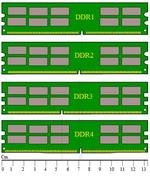RAM and ROM Verilog Code Examples
Advertisement
This page covers RAM Verilog code and ROM Verilog code. It also provides a link that compares RAM vs ROM.
RAM Verilog Code
Following is the figure and Verilog code of RAM (Random Access Memory).

module RAM_code(out, in, addr, RW, CS);
output [7:0] out;
input [7:0] in;
input [3:0] addr;
input RW, CS;
reg [7:0] out;
reg [7:0] DATA[15:0];
always @(negedge CS) begin
if(RW==1'b0) //READ
out=DATA[addr];
else if(RW==1'b1) //WRITE
DATA[addr]=in;
else
out=8'bz;
end
endmodule
ROM Verilog Code
Following is the figure and Verilog code of ROM (Read Only Memory).

module ROM_code(out, addr, CS);
output[15:0] out;
input[3:0] addr;
input CS;
reg [15:0] out;
reg [15:0] ROM[15:0];
always @(negedge CS) begin
ROM[0]=16'h5601;
ROM[1]=16'h3401;
ROM[2]=16'h1801;
ROM[3]=16'h0ac1;
ROM[4]=16'h0521;
ROM[5]=16'h0221;
ROM[6]=16'h5601;
ROM[7]=16'h5401;
ROM[8]=16'h4801;
ROM[9]=16'h3801;
ROM[10]=16'h3001;
ROM[11]=16'h2401;
ROM[12]=16'h1c01;
ROM[13]=16'h1601;
ROM[14]=16'h5601;
ROM[15]=16'h5401;
out=ROM[addr];
end
endmodule
Advertisement
 RF
RF



